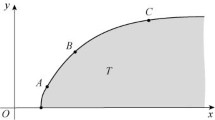Abstract
In this paper, we use simulations to investigate the relationship between data envelopment analysis (DEA) efficiency and major production functions: Cobb-Douglas, the constant elasticity of substitution, and the transcendental logarithmic. Two DEA models were used: a constant return to scale (CCR model), and a variable return to scale (BCC model). Each of the models was investigated in two versions: with bounded and unbounded weights. Two cases were simulated: with and without errors in the production functions estimation. Various degrees of homogeneity (of the production function) were tested, reflecting a constant increasing and decreasing return to scale. With respect to the case with errors, three distribution functions were utilized: uniform, normal, and double exponential. For each distribution, 16 levels of the coefficient of variance (CV) were used. In all the tested cases, two measures were analysed: the percentage of efficient units (from the total number of units), and the average efficiency score. We applied a regression analysis to test the relationship between these two efficiency measures and the above parameters. Overall, we found that the degree of homogeneity has the largest effect on efficiency. Efficiency declines as the errors grow (as reflected by larger CV and of the expansion of the probability distribution function away from the centre). The bounds on the weights tend to smooth the effect, and bring the various DEA versions closer to one other. The type of efficiency measure has similar regression tendencies. Finally, the relationship between the efficiency measures and the explanatory variables is quadratic.
Similar content being viewed by others
References
Arrow KJ, Chenery HB, Minhas BS, Solow RM (1961) Capital-labour sub-situation and economic efficiency. Rev Econ Stat 9(3): 225–250
Banker RD, Chang H (1995) A simulation study of hypothesis tests for differences in efficiencies. Int J Prod Econ 39(1–2): 37–54
Banker RD, Charnes A, Cooper WW (1984) Some models for scale inefficiencies in DEA analysis. Manag Sci 30(9): 1078–1092
Chambers RG, Chung Y, Färe R (1998) Profit directional distance functions and Nerlovian efficiency. J Optim Theory Appl 98(2): 351–364
Charnes A, Cooper WW (1984) The non-archimedean CCR ratio for efficiency analysis: a rejoinder to Boyyd and Fare. Eur J Oper Res 15(3): 333–334
Charnes A, Cooper WW, Rhodes E (1978) Measuring the efficiency of decision-making units. Eur J Oper Res 2(6): 429–444
Charnes A, Cooper WW, Rhodes E (1979) Short communication: measuring the efficiency of decision making units. Eur J Oper Res 3(4): 339
Charnes A, Cooper WW, Golany B, Seiford L, Stutz J (1985) Foundations of data envelopment analysis for Pareto–Koopmans efficient empirical production functions. J Econ 30(1–2): 91–107
Debreu G (1951) The coefficient of the resource utilization. Econometrica 19(3): 273–292
Emrouznejad A, Barnett RP, Tavares G (2008) Evaluation of research in efficiency and productivity: a survey and analysis of the first 30 years of scholarly literature in DEA. Socio Econ Plan Sci 42(3): 151–157
Färe R, Lovell CAK (1978) Measuring the technical efficiency of production. J Econ Theory 19: 150–162
Farrell MJ (1957) The measurement of productive efficiency. J R Stat Soc Ser A 120(3): 253–290
Hadad Y, Sinuany-Stern Z, Mehrez A (2003a) Effect of variations on efficiency of decision-making units with respect to output, output estimated by production functions, and output differences. Central Eur J Oper Res 11(4): 351–367
Hadad Y, Sinuany-Stern Z, Mehrez A (2003b) DEA efficiency in relation to production function: a simulation study. Commun Dependability Quality Manag 6(3): 91–103
Hadad Y, Friedman L, Sinuany-Stern Z, Ben-Yair A (2008) Ranking method based on the difference between weighted output and input. Comput Model New Technol 12(3): 55–65
Hisnanick JJ, Kymn KO (1999) Modelling economies of scale: the case of US electric power companies. Energy Econ 21(3): 225–237
Hogg RV (1972) More light on the Kurtosis and related statistics. J Am Stat Assoc 67: 422–424
Mehrez A, Stulman A (1982) Some aspects of the distributional properties of the expected value of perfect information (EVPI). Oper Res Soc 33: 827–836
Seiford LM (1994) Data envelopment analysis: the evolution of the state of the art (1978–1995). J Prod Anal 7(2–3): 99–137
Sengupta JK, Sfeir RE (1988) Efficiency measurement by data envelopment analysis with econometric applications. Appl Econ 20(6): 285–293
Shephard RW (1970) Cost and production function. Princeton University Press, Princeton
Simar L, Wilson PW (2007) Estimation and inference in two-stage, semi-parametric models of production processes. J Econ 136(1): 31–64
Sueyoshi T (1994) Stochastic frontier production analysis; measuring performance of public telecommunications in 24 OECD countries. Eur J Oper Res 74: 466–478
Sueyoshi T (1997) Measuring efficiencies and returns to scale of Nippon telegraph telephone in production and cost analyses. Manag Sci 43(6): 779–796
Sueyoshi T, Sekitani K (2009) An occurrence of multiple projections in DEA-based measurement of technical efficiency: theoretical comparison among DEA models from desirable properties. J Oper Res 196(2): 764–794
Tavares G (2002) A bibliography of DEA (1978–2001), RRR 01-2002, RUTCOT-Rutgers Centre for OR. Rutgers University, New Jersey
Thompson RG, Langemeier LN, Lee C-T, Lee E, Thrall RM (1990) The role of multiplier bounds in efficiency analysis with application to Kansas farming. J Econ 46(2): 93–108
Varian HR (1992) Microeconomic analysis, 3rd edn. W.W. Norton, New York
Zieschang KD (1984) An extended Farrell technical efficiency measure. J Econ Theory 33: 387–396
Author information
Authors and Affiliations
Corresponding author
Rights and permissions
About this article
Cite this article
Hadad, Y., Friedman, L., Rybalkin, V. et al. The relationship between DEA efficiency and the type of production function, the degree of homogeneity, and error variability. Cent Eur J Oper Res 21, 595–607 (2013). https://doi.org/10.1007/s10100-012-0249-4
Published:
Issue Date:
DOI: https://doi.org/10.1007/s10100-012-0249-4




